Dialogue, a video series
January 14-March 25, 2011
Christian Marclay, Roy Villevoye and Jan Dietvorst, Rachel Perry Welty
Curated by Dan Mills
Dialogue is a winter semester video series featuring several prominent contemporary artists: Christian Marclay (New York), Roy Villevoye and Jan Dietvorst (Amsterdam), and Rachel Perry Welty (Boston). Reflecting Bates’ fundamental dedication to good conversation and an open exchange of ideas and artistic expression, the artists explore dialogue and communication in videos that are profound, humorous, and provocative.
Christian Marclay Telephones, 1995, video, sound 7:30 minutes
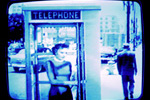

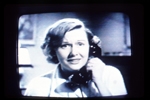
Telephones, 1995 video, sound, 7:30 minutes.
Screening continuously January 14 – February 4
Artist/composer Christian Marclay (American, b. 1955) is known for inventively exploring connections between a wide range of media. Making work that transcends disciplinary boundaries, he transforms sound and music into visual and physical forms through performance, collage, sculpture, large-scale installations, photography, and video.
The short and intense video Telephones is a visual composition comprised of footage from Hollywood films that foreground both the image and sound of the telephone, and construct a new narrative out of the actors’ responses and their clipped dialogue.
His recent exhibition at the Whitney Museum of American Art,Christian Marclay: Festival, was activated by daily concerts that included playing a dozen of the artist’s scores and works that served as scores, a collective musical score created on a wall-sized chalkboard. These were interpreted by a revolving group of world renowned musicians and vocalists, some of whom have been regular collaborators with the artist for three decades.
Rachel Perry Welty Karaoke Wrong Number, 2004, video on DVD. Edition of 25, 6:52 minutes
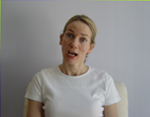
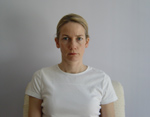
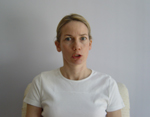
Karaoke Wrong Number, 2004 video on DVD. Edition of 25, 6:52 minutes.
Screening continuously February 5 – March 3
Rachel Perry Welty (American, b. Tokyo 1962) states the following about the video Karaoke Wrong Number, which depicts the artist lip-synching to wrong number messages:
“This work came about after I received a spate of wrong number calls on my answering machine. I couldn’t bear to erase the messages. They were humorous, unnerving, and mundane; each had an urgency that I wanted to address. The disembodied voice that I work with at the beginning is a lady calling to complain about dust in the church. She is nice about it, but she clearly wants the priest to know how difficult it is for her and the choir to practice. It is humorous, but also poignant, how she assumed that the information was going to get to the proper person. It made me realize that we are always just a hair’s breadth away from completely misunderstanding one another. And it made me consider how we shed information about ourselves as we move through our lives. That got me thinking about issues of privacy and how technology both helps and impedes communication.”
From an interview with Francine Koslow Miller for Sculpture Magazine.
Roy Villevoye & Jan Dietvorst Owner of the Voyage, 2007, digital video 16 minutes
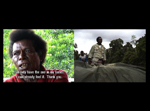
Owner of the Voyage, 2007 digital video, 16 minutes.
Screening continuously March 4 – March 25
Since the early 1990s, Dutch artist Roy Villevoye (Dutch, b. 1960) has made frequent and extended visits Papua, the former Dutch New Guinea. Visual artist Jan Dietvorst (Dutch, b. 1953) has joined him regularly; together they produce an oeuvre of films that deal with the outside influences that the local people, the Asmat, have been exposed since their first contact with Western outsiders in the 1950s.
In 2000, two of Villevoye’s long-time Asmat friends, brothers Rufus Satí and Rodan Omomá, made a journey to the Netherlands. A year later their cousin and trusted friend Pupís is interviewed about the two brothers’ adventures. Owner of the Voyage, a double projection video, simultaneously presents the clips of the journey juxtaposed with a third person story of their travels. In the interview Pupís, whose own travel experience is limited to neighboring villages, reconstructs the brothers’ experiences from his own unique perspective; without being asked, he incorporates his own personal agenda within his report.